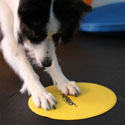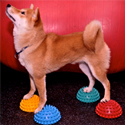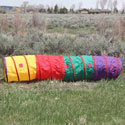Agility can be a fun sport for anyone. That is the premise behind Agility Right from the Start, celebrating its first birthday this month. Praised for adding needed clarity to the application of clicker training to agility, the book by Swedish agility experts Eva Bertilsson and Emelie Johnson Vegh has taken the agility world by storm.
Its comprehensive approach and focus on good handling has made Agility Right from the Start a must-have resource for both the beginner and the most accomplished competitor. Many agility participants describe the book as the only agility resource they’ll ever need. But perhaps what is most significant about this book is that the foundation skills that Bertilsson and Vegh outline not only apply to agility, but to all dog sports—and to everyday life. What kind of foundation training are we talking about? Training that uses positive reinforcement and that focuses on building behavior step-by-step. This type of training is not only key to creating a happy and confident team, but is the invaluable recipe for getting any behavior you want—right from the start.
It’s been one year since the release of Agility Right from the Start. Do you think that the book has helped bring clicker training into the agility community?
Bertilsson & Vegh: We hope so. We do feel that it helps to provide tools to utilize the principles of clicker training from the very first steps of agility training, and to give a picture of how that can work throughout training. Plus, the tag points for the trainer/handler that are in the book seem to have sparked people’s imagination. We’ve also been pleased to hear that quite a few people already familiar with positive reinforcement training have a new or renewed interest in agility due to our book.
What about those agility trainers that do not use the clicker. Can they still benefit from your book?
Bertilsson & Vegh: Most definitely. Remember, the clicker is merely a tool—it’s the principles that matter! The training we promote revolves around principles of clicker training (in short, making sure to reinforce what you like, and not reinforce the stuff you don’t want, and controlling the environment so that you set your dog up for success), and “Good Agility Practices” (in short, focus, intensity, and staying true to your system of handling). The book tells you all about that, and discusses ways to create “Great Training Sessions,” where you and your dog learn as fast, as smoothly, and with as much fun as possible.
One of the misperceptions about agility is that only “smart, fast” dogs can do it. Is this true? What about other animals?
Bertilsson & Vegh: Agility is a great sport, and the training truly is for everybody! Even dogs that aren’t physically fit to do agility on a competition level can have lots of fun and build useful skills through selected parts of the agility training. You just need to design a training program that fits you and your dog! As far as smartness goes, clicker training is a great way to discover your dog’s “inner genius.” By setting up appropriate training situations, each and every dog gets a chance to excel.
What is the benefit of doing agility with your dog, and when is the best time to start?
Bertilsson & Vegh: Agility is fun! And, any kind of training is a great way to create a bond with your dog. The agility community also gives ample social opportunities for the handler. You can begin agility training the way we do it, from the get go with your puppy. There are so many things to do that are safe, that won’t strain a puppy’s body, and that will build valuable skills both for future agility and for other aspects of your life together.
What’s the most important piece of advice you would offer to someone who is just starting out?
Bertilsson & Vegh: First and foremost, make “a happy and confident attitude” your top priority. In the greater scheme of things, our canine partners’ wellbeing is what’s most important. As long as your training is contributing to your dog’s wellbeing, you’re on the right track!
In the beginning you should focus on establishing the features needed for great training sessions, where both you and your dog can work with top focus and intensity. This assignment encompasses building fun and functional reward procedures, creating habits where your dog is never left in limbo (we suggest utilizing transports and stations to cover any gaps in space or time), and learning and polishing various strategies to get behavior (like our “Aim for it” and “Race to reward” procedures).
When it comes to building specific skills, we’re strong proponents of setting up situations where the dog learns to offer little bits of behavior on his own. So never mind “getting him to do” this or that. Instead, strive to arrange situations where your dog spontaneously performs behaviors that you can reward.
Can the lessons in your book transcend to other canine sports? How?
Bertilsson & Vegh: Following the underlying principles of learning naturally isn’t in any way tied to agility—that goes for life. We have found that “Good Agility Practices” really is a somewhat misleading name, since our definition of these practices enhances all forms of training for any sport. Maintaining focus on your dog and your training, staying in that “bubble,” working with intensity and purpose, and making sure to move yourself and your dog around in a way that correlates with your goals will help you make every training session great. What’s more, those practices will make training sessions fun and will propel your training forward!
The skills you teach in your book seem to be skills that any dog can benefit from in everyday life. Can you tell us more about that?
Bertilsson & Vegh: We’d like to think that it’s the human side of the partnership that learns the most valuable lessons. Understanding how positive reinforcement works is life-altering! Learning to look at the dog’s behavior, to set up for success, and to catch him being right allows you to teach your dog anything you want him to learn, thus making everyday life go smoother.
Some of our agility skills are also directly beneficial for everyday life. The most obvious examples are noise and movement, where we actually transform potentially scary stimuli into rewarding events, but we’d also like to mention rear-end control (coordination and balance help your dog stay safe) and the strategy of “Aim for it” (learning to learn through shaping in miniscule steps is a skill that can be used for just about anything).
We’re excited that you’ll once again be presenting at ClickerExpo Chicago (March 18-20, 2011). Can you give us a sneak peak of your Sessions?
Bertilsson & Vegh: We are returning to our foundation seminar on Agility Right from the Start, explaining how we think about training, agility, and foundation skills for both dog and handler. We have also been let loose on the subject of shaping for agility purposes, something we are very excited about! Getting into the nitty gritty, the itsy details of a shaping session, is so much fun, and really helps clear away any cobwebs in your training (whether it’s agility or something else). That shaping Session also comes with a Lab, where we get up close and personal with the details of a great training session. Finally, we have a Session on noise and movement training, something that really changed our own training. Getting your dog to like, create, and demand noise and movement not only helps him be a great agility dog, but also helps him find a great and self confident place in our human world!








agility for adults?
Can adult dogs that have not been agility trained before be taught to do this? And would this book benefit owners of new adult dogs?
Post new comment